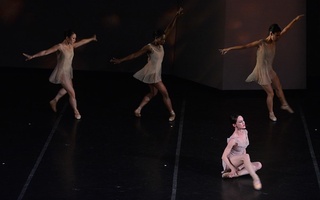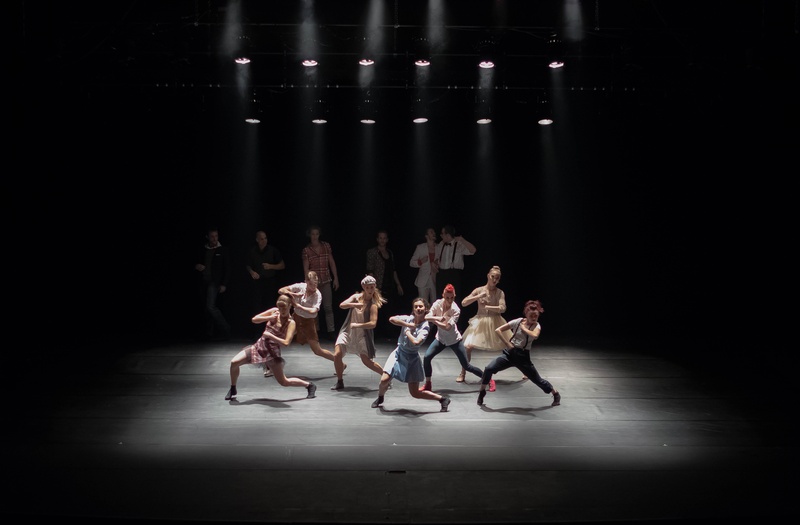Showing on Feb. 2 and 3 at the Emerson Cutler Majestic Theatre in Boston, Ballets Jazz Montréal’s new production “BJM/Les Ballets Jazz de Montréal” set lofty goals for itself. The show’s three acts sought to subvert the Western conception of the patriarchy, pay tribute to Leonard Cohen, and capture the free spirit of Cuban dance, but despite these intention, the program was not entirely successful in its mission.
From the start, the show was plagued with technical difficulties, such as the emcee Susan Weiler’s microphone failing to turn on. This minor error foreshadowed not only later logistical issues, but was also symbolic for the show on the whole: The voice and message were there, but they would be drowned out in a sea of spectacle.
The troupe’s opening dance, “Casualties of Memory,” attempted to promote an egalitarian message but lost focus and was ultimately unsuccessful. It began with a male-female pair of dancers who engage in a beautiful, technically skilled routine in which each dancer’s movement complemented the other. No movement was distinctly male or female, and no one dancer dominated. This gender-neutral approach complements the stated aim of the piece completely.
The message was further complicated when the tempo suddenly picked up. eavy North African percussion instruments replaced soft, droning strings. As the rest of the troupe entered the stage, the dance changed from elegant to explosive, with performers contorting their bodies with such force and speed that it is a wonder how they continued for forty minutes.
At various points during the performance, dancers waved their hands above their heads while jumping and breaking out into ululation and shrieking, presumably in a homage to the culture from which they borrowed their drums. While this part might have been intended to blend ethnic and contemporary dance in such a way as to emphasize gender equality, the connection between powerful North African-inspired movements and subverting the patriarchy did not make much sense.
In fact, this new element drowned out the original feminist message. At other points, the egalitarian themes shone through more clearly like when the dancers arranged themselves in a gender-neutral fashion and pas de deux pairings subverted traditional notions of a male-female pairing. While the dancers themselves performed unbelievable feats masterfully, the choreography was crushed under the weight of its own message.
“Dance Me,” a four part homage to fellow Montréal native Leonard Cohen, was the peak of the show. Conceptual, focused, and deeply touching—each performance was a meditation on the late artist’s work. Andonis Foniadakis’ choreography to Cohen’s “Boogie Street” was so sensual, smooth, and deeply satisfying that one almost gets the sense that the song was commissioned for the dance and not the other way around. The silky movements of “Boogie Street” and the stunning vocal rendition of “Marianne” provided a much needed reprieve from the violent moves of the first act. “Dance Me” ended with a moving depiction of Cohen’s song “Suzanne.” Here, the dancers intertwined and connected intimately to mimic the way Cohen describes touching the body of your lover “with your mind.”
Off the heels of the deeply emotional and intimate “Dance Me” comes the show’s “O Balcão de Amor,” which had a physical and slapstick nature that was at times detrimental. Inspired by the choreographer’s trip to Cuba, the piece is supposed to be loose, sexy, and full of absurdity. However, much like the rest of the show, it toed the line between homage and caricature. The performers changed out of the tights they sported for the majority of the show, and instead wore costumes to represent their personality in the piece. For example, the main character—a bumbling nerd—was dressed in a bowtie and suspenders. While the performers nailed the choreography, the overdone skits ruined whatever physical feat and artistic mastery may have been there.
Frequent technical difficulties dampened the mastery of the choreography. Halfway through the performance the music stopped, but the performers continued their repertoire without missing a beat. The curtain closed and the lights dimmed. While this might have seemed like it was a part of the performance, it was just a technical error and forced the production to restart.
Besides the suspect cultural homages, the overdone slapstick, and technical errors, Ballets Jazz Montréal had a great show. There were moments of genuine emotion without pretension that were impactful; however, the majority unfortunately got lost in superfluity.
—Staff writer Raj Gambhir can be reached at raj.gambhir@thecrimson.com.
Read more in Arts
Alumni Spotlight: Elise M. Paschen '81Recommended Articles
-
Put on Your Dancing GumbootsThe arts scene at Harvard has seen a proliferation in the number of dance groups on campus. One such group
-
Inching Into ApparitionT HERE'S A LOT of missionary zeal in the dance world. Many dancers find themselves still fighting the battle Martha
-
All Form and No FeelingI ONCE SAW a modern dance performance, inspired during the few years when "happenings" were in vogue. It consisted of,
-
"40" Never Looked So GoodThe Harvard Radcliffe Modern Dance Company’s new show “40,” proves that at their middle age, the dance troupe is as graceful as it’s ever been and promises many more decades of inspired modern dance.
-
 José Mateo Ballet’s “Assault on the Senses” Blends Vigor With Grace
José Mateo Ballet’s “Assault on the Senses” Blends Vigor With Grace














